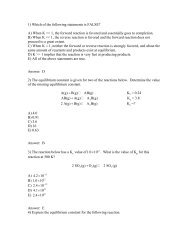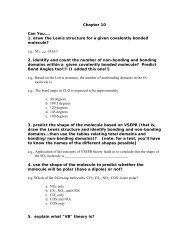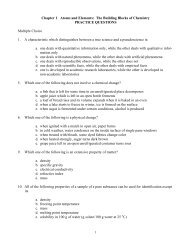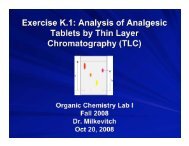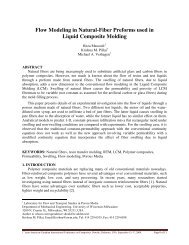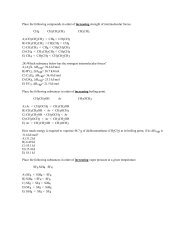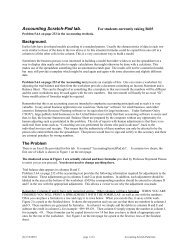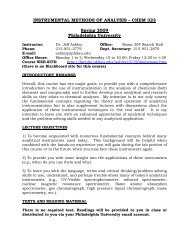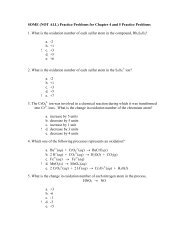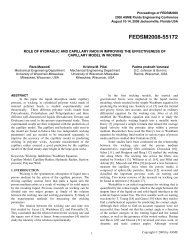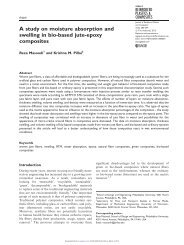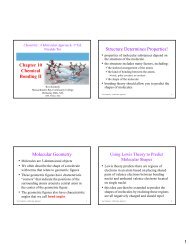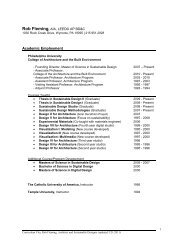PRACTICE PROBLEMS FOR TEST 2 (March 11, 2009) 1) What is ...
PRACTICE PROBLEMS FOR TEST 2 (March 11, 2009) 1) What is ...
PRACTICE PROBLEMS FOR TEST 2 (March 11, 2009) 1) What is ...
You also want an ePaper? Increase the reach of your titles
YUMPU automatically turns print PDFs into web optimized ePapers that Google loves.
<strong>PRACTICE</strong> <strong>PROBLEMS</strong> <strong>FOR</strong> <strong>TEST</strong> 2 (<strong>March</strong> <strong>11</strong>, <strong>2009</strong>)<br />
1) <strong>What</strong> <strong>is</strong> the overall order of the following reaction, given the rate law?<br />
A) 1st order<br />
B) 2nd order<br />
C) 3rd order<br />
D) 4th order<br />
E) 0th order<br />
2NO(g) + H<br />
2(g) → N<br />
2(g) + 2H2O(g)<br />
Rate = k[NO]2[H2]<br />
Answer: C<br />
2) Given the following rate law, how does the rate of reaction change if the concentration<br />
of Y <strong>is</strong> doubled?<br />
Rate = k [X][Y]2<br />
A) The rate of reaction will increase by a factor of 2.<br />
B) The rate of reaction will increase by a factor of 4.<br />
C) The rate of reaction will increase by a factor of 5.<br />
D) The rate of reaction will decrease by a factor of 2.<br />
E) The rate of reaction will remain unchanged.<br />
Answer: B<br />
3) Determine the rate law and the value of k for the following reaction using the data<br />
provided.<br />
S O (aq) + 3 I (aq) → 2 SO (g) + I (aq)<br />
2− − 2− −<br />
2 8 4 3<br />
[S2O8 2 − ] i (M) [I − ]i (M) Initial Rate (M-1s-1)<br />
0.30 0.42 4.54<br />
0.44 0.42 6.65<br />
0.44 0.21 3.33<br />
−2 −1<br />
2<br />
A) Rate = 120 M s [ SO − 2 8<br />
]2[I − ]<br />
−1 −1 2−<br />
-<br />
B) Rate = 36 M s [S O ][I ]<br />
C) Rate =<br />
D) Rate =<br />
2 8<br />
−<br />
-2 -1 2 - 2<br />
86 M s [S2O 8<br />
][I ]<br />
-3 -1 2- 2 - 2<br />
195 M s [S2O 8<br />
] [I ]
E) Rate =<br />
-1/2 -1 2- - 1/2<br />
23 M s [S2O 8<br />
][I ]<br />
4) Which of the following represents the integrated rate law for a first-order reaction?<br />
A)<br />
[ ]<br />
[ ]<br />
At<br />
ln = - kt Ao<br />
1 1 = kt<br />
Ao<br />
B) −<br />
[ At ] [ ]<br />
C) [ At ] − [ ]<br />
Ao= - kt<br />
⎛<br />
Ea<br />
⎞<br />
⎜ ⎟<br />
−<br />
⎜<br />
D) k = Ae<br />
RT<br />
⎟<br />
⎝ ⎠<br />
k<br />
2<br />
E) ln = Ea ⎛ 1 ⎞<br />
⎜ ⎟<br />
k R ⎝T⎠ + lnA<br />
1<br />
Answer: A<br />
5) <strong>What</strong> data should be plotted to show that experimental concentration data fits a firstorder<br />
reaction?<br />
A) 1/[reactant] vs. time<br />
B) [reactant] vs. time<br />
C) ln[reactant] vs. time<br />
D) ln(k) vs. 1/T<br />
E) ln(k) vs. Ea<br />
Answer: C<br />
6) The first-order decay of radon has a half-life of 3.823 days. How many grams of<br />
radon remain after 7.22 days if the sample initially weighs 250.0 grams?<br />
A) 4.21 g<br />
B) 183 g<br />
C) 54.8 g<br />
D) 76.3 g<br />
E) 67.5 g<br />
Answer: E<br />
−3 −1<br />
7) The first-order decomposition of N2O5 at 328 K has a rate constant of 1.70 × 10 s .<br />
If the initial concentration of N2O5 <strong>is</strong> 2.88 M, what <strong>is</strong> the concentration of N2O5 after
12.5 minutes?<br />
A) 0.124 M<br />
B) 0.805 M<br />
C) 2.82 M<br />
D) 0.355 M<br />
E) 0.174 M<br />
Answer: B<br />
−3 −1 −1<br />
8) The second-order decomposition of HI has a rate constant of 1.80 × 10 M s . How<br />
much HI remains after 27.3 s if the initial concentration of HI <strong>is</strong> 4.78 M?<br />
A) 4.55 M<br />
B) 0.258 M<br />
C) 3.87 M<br />
D) 2.20 M<br />
E) 2.39 M<br />
Answer: C<br />
9) The half-life for the second-order decomposition of HI <strong>is</strong> 15.4 s when the initial<br />
concentration of HI <strong>is</strong> 0.67 M. <strong>What</strong> <strong>is</strong> the rate constant for th<strong>is</strong> reaction?<br />
−2 −1 −1<br />
A) 1.0 × 10 M s<br />
−2 −1 −1<br />
B) 4.5×<br />
10 M s<br />
−2 −1 −1<br />
C) 9.7×<br />
10 M s<br />
−2 −1 −1<br />
D) 2.2×<br />
10 M s<br />
−2 −1 −1<br />
E) 3.8×<br />
10 M s<br />
Answer: C<br />
10) Derive an expression for a "1/3-life" for a first-order reaction.<br />
[ ]<br />
At<br />
ln<br />
[ Ao ]<br />
A)<br />
−k<br />
B) 0.462<br />
k<br />
[ At ]<br />
ln<br />
[ Ao ]<br />
C)<br />
−3k
D) 1.099<br />
k<br />
E) 3 k<br />
Answer: D<br />
<strong>11</strong>) MIX AND MATCH<br />
61) k A) frequency factor<br />
62) t<br />
1<br />
B) activation energy<br />
2<br />
63) Ea C) half-life<br />
64) A D) reaction order<br />
65) n, in Rate = k[A]n E) rate constant<br />
Answer:<br />
61 – E<br />
62 – C<br />
63 – B<br />
64 – A<br />
65 – D<br />
12) Which of the following compounds will be most soluble in ethanol (CH 3<br />
CH 2<br />
OH)?<br />
A) trimethylamine (N(CH 3<br />
) 3<br />
)<br />
B) acetone (CH 3<br />
COCH 3<br />
)<br />
C) ethylene glycol (HOCH 2<br />
CH 2<br />
OH)<br />
D) hexane (CH 3<br />
CH 2<br />
CH 2<br />
CH 2<br />
CH 2<br />
CH 3<br />
)<br />
E) None of these compounds should be soluble in methanol.<br />
Answer: C<br />
13) Determine the solubility of N 2<br />
in water exposed to air at 25°C if the atmospheric<br />
pressure <strong>is</strong> 1.2 atm. Assume that the mole fraction of nitrogen <strong>is</strong> 0.78 in air and the<br />
−4<br />
Henry's law constant for nitrogen in water at th<strong>is</strong> temperature <strong>is</strong> 6.1× 10 M/atm .<br />
−4<br />
A) 1.5×<br />
10 M<br />
−4<br />
B) 6.5×<br />
10 M<br />
−4<br />
C) 5.7×<br />
10 M<br />
−4<br />
D) 1.8×<br />
10 M<br />
−4<br />
E) 3.6×<br />
10 M
Answer: C<br />
14) Which of the following concentration units are temperature dependent?<br />
A) Mole fraction<br />
B) Molality<br />
C) Mass percent<br />
D) Molarity<br />
E) None of the above.<br />
Answer: D<br />
15) Calculate the molality of a solution formed by d<strong>is</strong>solving 27.8 g of LiI in 500.0 mL of<br />
water.<br />
A) 0.254 m<br />
B) 0.394 m<br />
C) 0.556 m<br />
D) 0.241 m<br />
E) 0.415 m<br />
Answer: E<br />
16) Calculate the molality of a solution that <strong>is</strong> prepared by mixing 25.5 mL of CH 3<br />
OH<br />
(d= 0.792 g/mL) and 387 mL of CH3CH2CH2OH (d= 0.8<strong>11</strong> g/mL).<br />
A) 0.630 m<br />
B) 0.812 m<br />
C) 1.57 m<br />
D) 2.01 m<br />
E) 4.98 m<br />
Answer: D<br />
17) Commercial grade HCl solutions are typically 39.0% (by mass) HCl in water.<br />
Determine the molality of the HCl, if the solution has a density of 1.20 g/mL.<br />
A) 39.0 m<br />
B) 17.5 m<br />
C) 6.39 m<br />
D) 10.7 m<br />
E) 9.44 m
Answer: B<br />
18) An aqueous solution <strong>is</strong> 0.387 M in HCl. <strong>What</strong> <strong>is</strong> the molality of the solution if the<br />
density <strong>is</strong> 1.23 g/mL?<br />
A) 0.<strong>11</strong>5 m<br />
B) 0.387 m<br />
C) 0.315 m<br />
D) 0.4<strong>11</strong> m<br />
E) 0.318 m<br />
Answer: E<br />
19) A solution <strong>is</strong> prepared by d<strong>is</strong>solving 38.6 g sucrose (C 12<br />
H 22<br />
O <strong>11</strong><br />
) in 495 g of water.<br />
Determine the mole fraction of sucrose if the final volume of the solution <strong>is</strong> 508 mL.<br />
A) 4.09×<br />
10 −3<br />
B) 7.80×<br />
10 −2<br />
3<br />
C) 1.28× 10 −<br />
D) 7.23×<br />
10 −2<br />
3<br />
E) 2.45× 10 −<br />
Answer: A<br />
20) Calculate the mole fraction of total ions in an aqueous solution prepared by<br />
d<strong>is</strong>solving 0.400 moles of MgCl 2<br />
in 850.0 g of water.<br />
A) 0.00841<br />
B) 0.0254<br />
C) 0.00848<br />
D) 0.0248<br />
E) 0.0167<br />
Answer: D<br />
21) Determine the vapor pressure of a solution at 25°C that contains 76.6 g of glucose<br />
(C 6<br />
H 12<br />
O 6<br />
) in 250.0 mL of water. The vapor pressure of pure water at 25°C <strong>is</strong> 23.8 torr.<br />
A) 70.8 torr<br />
B) 72.9 torr<br />
C) 23.1 torr<br />
D) 22.9 torr<br />
E) 7.29 torr
Answer: C<br />
22) Determine the vapor pressure of a solution at 55°C that contains 34.2 g NaCl in 375<br />
mL of water. The vapor pressure of pure water at 55°C <strong>is</strong> <strong>11</strong>8.1 torr.<br />
A) <strong>11</strong>5 torr<br />
B) 87.1 torr<br />
C) 108 torr<br />
D) <strong>11</strong>2 torr<br />
E) 92.8 torr<br />
Answer: D<br />
23) Determine the freezing point depression of a solution that contains 30.7 g glycerin<br />
(C 3<br />
H 8<br />
O 3<br />
, molar mass = 92.09 g/mol) in 376 mL of water. Some possibly useful<br />
constants for water are K f<br />
= 1.86°C/m and K b<br />
= 0.512°C/m.<br />
A) 0.887°C<br />
B) -1.65°C<br />
C) 3.33°C<br />
D) -3.33°C<br />
E) 0.654°C<br />
Answer: B<br />
24. When a solute such as ammonium sulfate <strong>is</strong> d<strong>is</strong>solved in a solvent like water, one of<br />
the observed effects <strong>is</strong><br />
! a. a decrease in the vapor pressure of the solvent<br />
b. an increase in the vapor pressure of the solute<br />
c. an increase in the melting point of the liquid<br />
d. a decrease in the boiling point of the liquid<br />
e. scattering of light beams by the solute particles in the solution<br />
25. At 28.0 o C, the vapor pressure of n-propyl mercaptan, C 3 H 7 SH, <strong>is</strong> 175 torr, while that<br />
of acetonitrile, CH 3 CN, <strong>is</strong> 102 torr. <strong>What</strong> <strong>is</strong> the vapor pressure, at 28.0 o C, of a<br />
solution made by mixing 100.0 g of C 3 H 7 SH and 100.0 g CH 3 CN, if Raoult's Law <strong>is</strong><br />
obeyed?<br />
a. 35.7 torr<br />
! b. 128 torr<br />
c. 139 torr<br />
d. 149 torr<br />
e. 277 torr



